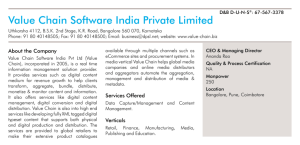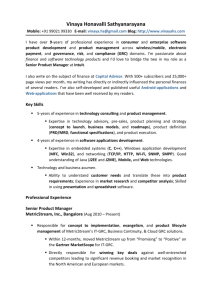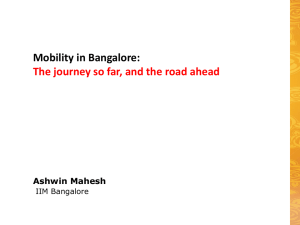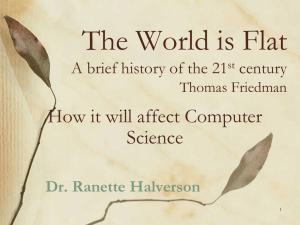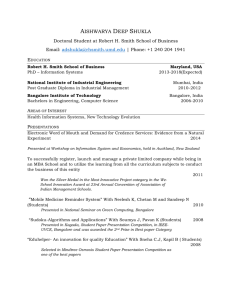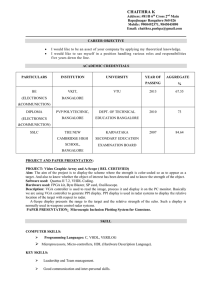CITIES IN TRANSISTION: Impact of Information Technology
advertisement
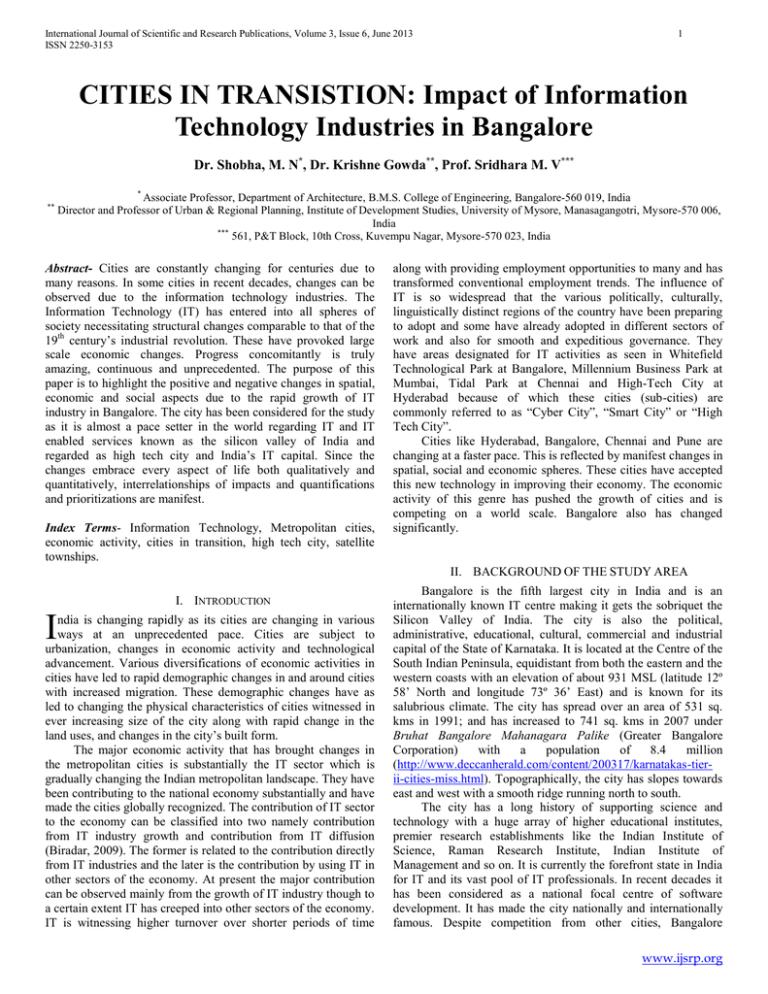
International Journal of Scientific and Research Publications, Volume 3, Issue 6, June 2013 ISSN 2250-3153 1 CITIES IN TRANSISTION: Impact of Information Technology Industries in Bangalore Dr. Shobha, M. N*, Dr. Krishne Gowda**, Prof. Sridhara M. V*** ** * Associate Professor, Department of Architecture, B.M.S. College of Engineering, Bangalore-560 019, India Director and Professor of Urban & Regional Planning, Institute of Development Studies, University of Mysore, Manasagangotri, Mysore-570 006, India *** 561, P&T Block, 10th Cross, Kuvempu Nagar, Mysore-570 023, India Abstract- Cities are constantly changing for centuries due to many reasons. In some cities in recent decades, changes can be observed due to the information technology industries. The Information Technology (IT) has entered into all spheres of society necessitating structural changes comparable to that of the 19th century’s industrial revolution. These have provoked large scale economic changes. Progress concomitantly is truly amazing, continuous and unprecedented. The purpose of this paper is to highlight the positive and negative changes in spatial, economic and social aspects due to the rapid growth of IT industry in Bangalore. The city has been considered for the study as it is almost a pace setter in the world regarding IT and IT enabled services known as the silicon valley of India and regarded as high tech city and India’s IT capital. Since the changes embrace every aspect of life both qualitatively and quantitatively, interrelationships of impacts and quantifications and prioritizations are manifest. Index Terms- Information Technology, Metropolitan cities, economic activity, cities in transition, high tech city, satellite townships. along with providing employment opportunities to many and has transformed conventional employment trends. The influence of IT is so widespread that the various politically, culturally, linguistically distinct regions of the country have been preparing to adopt and some have already adopted in different sectors of work and also for smooth and expeditious governance. They have areas designated for IT activities as seen in Whitefield Technological Park at Bangalore, Millennium Business Park at Mumbai, Tidal Park at Chennai and High-Tech City at Hyderabad because of which these cities (sub-cities) are commonly referred to as “Cyber City”, “Smart City” or “High Tech City”. Cities like Hyderabad, Bangalore, Chennai and Pune are changing at a faster pace. This is reflected by manifest changes in spatial, social and economic spheres. These cities have accepted this new technology in improving their economy. The economic activity of this genre has pushed the growth of cities and is competing on a world scale. Bangalore also has changed significantly. II. BACKGROUND OF THE STUDY AREA I. INTRODUCTION I ndia is changing rapidly as its cities are changing in various ways at an unprecedented pace. Cities are subject to urbanization, changes in economic activity and technological advancement. Various diversifications of economic activities in cities have led to rapid demographic changes in and around cities with increased migration. These demographic changes have as led to changing the physical characteristics of cities witnessed in ever increasing size of the city along with rapid change in the land uses, and changes in the city’s built form. The major economic activity that has brought changes in the metropolitan cities is substantially the IT sector which is gradually changing the Indian metropolitan landscape. They have been contributing to the national economy substantially and have made the cities globally recognized. The contribution of IT sector to the economy can be classified into two namely contribution from IT industry growth and contribution from IT diffusion (Biradar, 2009). The former is related to the contribution directly from IT industries and the later is the contribution by using IT in other sectors of the economy. At present the major contribution can be observed mainly from the growth of IT industry though to a certain extent IT has creeped into other sectors of the economy. IT is witnessing higher turnover over shorter periods of time Bangalore is the fifth largest city in India and is an internationally known IT centre making it gets the sobriquet the Silicon Valley of India. The city is also the political, administrative, educational, cultural, commercial and industrial capital of the State of Karnataka. It is located at the Centre of the South Indian Peninsula, equidistant from both the eastern and the western coasts with an elevation of about 931 MSL (latitude 12º 58’ North and longitude 73º 36’ East) and is known for its salubrious climate. The city has spread over an area of 531 sq. kms in 1991; and has increased to 741 sq. kms in 2007 under Bruhat Bangalore Mahanagara Palike (Greater Bangalore Corporation) with a population of 8.4 million (http://www.deccanherald.com/content/200317/karnatakas-tierii-cities-miss.html). Topographically, the city has slopes towards east and west with a smooth ridge running north to south. The city has a long history of supporting science and technology with a huge array of higher educational institutes, premier research establishments like the Indian Institute of Science, Raman Research Institute, Indian Institute of Management and so on. It is currently the forefront state in India for IT and its vast pool of IT professionals. In recent decades it has been considered as a national focal centre of software development. It has made the city nationally and internationally famous. Despite competition from other cities, Bangalore www.ijsrp.org International Journal of Scientific and Research Publications, Volume 3, Issue 6, June 2013 ISSN 2250-3153 remains the number one IT destination. Bangalore is often compared to the original Silicon Valley based in Santa Clara Valley in California, a major hub for IT companies in the United States. In 1990 Bangalore emerged as the IT hub with a worldwide reputation; the concentration of electronics and aeronautical 2 industries in the public and private sector and specialized staterun research centers within the city. Later Electronic City in the southern part and Whitefield in the northern part were earmarked for IT industries (see Fig. 1). Fig. 1 Existing Location of Whitefield and Electronic City with IT Corridor International Airport Yelahanka Batarayanapura Dasarahalli Krishnarajapuram Whitefield Kengeri Mahadevapura Pattanagere Bommanahalli Electronic City Kilometers Source: Department of Information Technology, Biotechnology and Science & Technology, Government of Karnataka, Bangalore III. BANGALORE CITY IS IN TRANSITION Bangalore is the fastest growing city in Asia. According to the ‘Quality of living survey-Worldwide ranking, 2011’ by the global Human Resources consultancy major mercer, Bangalore has emerged as the best to live in India with a worldwide rank it has the 141st position in a list of 221 cities (Ninan, Abhilash Chalakuzhy, 2011). Several factors like historical, geographical, economic, cultural, and political, have contributed to its emergence. IT has been playing a major role leading to several changes. These influences are changing the cities both negatively and positively. The changes due to IT can be broadly classified as spatial, economic and social. 3.1 Spatial Changes: Massive developments are apace in residential layouts in the south-eastern and now due to improved connectivity developments are coming up in other areas also. Some years ago areas like Koramangala, Hosur Road, Bannerghatta Road, Sarjapur Road, Outer Ring Road, Hosur Sarjapur Road Layout, Jaya Prakashnarayan Nagar, Banashankari, Basavanagudi, Kanakapuran Road and neighboring areas were considered isolated for away areas with large expanses of land lying unutilized. But today they are posh, upscale neighborhoods with towering residential complexes along with large scale shopping enclaves. Even in and around the Electronic City residential development is fast. People working www.ijsrp.org International Journal of Scientific and Research Publications, Volume 3, Issue 6, June 2013 ISSN 2250-3153 in the Electronic City prefer to stay close to the work place and are investing for their second homes. The work home relationship and walk to work concept has created demand for 3 residential units in these areas (Plate 3.1.1). The IT sector has significantly changed the urban form. Plate 3.1.1 Apartments in Electronic City The huge demand for residential property and the consequent high land value have led to the rise of apartment houses. Apartments are also considered safer by many working families. The scope for socializing improves in the apartments with varieties of facilities available within one’s precincts. Highrise apartments, low-rise apartments and luxury apartments are available with many facilities like club house, gym, swimming pool and so on. Row houses, villas and gated communities can also be seen in suburbs (Plate 3.1.2). At present there is a new concept of city within the city with self-contained facilities like shops, schools, restaurants, hospitals, parks and so on. Plate 3.1.2 Villas and Apartments White Field There is a huge change in land use and transformation from residential to commercial land use (Plate 3.1.3). The IT offices were considered under commercial land use but at present in Revised Master Plan 2015, it is categorized under High Tech zone. Bangalore is the preferred location for high quality commercial space. There is a lot of demand from the IT and ITES sector and also other related activities indirectly serving to these sectors. Despite the deficiency in infrastructure facilities, From Koramangala Ring Road this sector prefers Bangalore due to the relatively ready availability of work force. IT/ITES sector remains the major demand driver for the city and demand is largely characterized by built–to-suit requirements, though the need for infrastructure is acutely rising amongst IT/ITES/Business Process Outsourcing companies. www.ijsrp.org International Journal of Scientific and Research Publications, Volume 3, Issue 6, June 2013 ISSN 2250-3153 4 Plate 3.1.3 Different IT influenced areas Jayanagar Jayanagar Whitefield Whitefield There is a translocation of commercial market to suburban areas due to the availability of less expensive land compared to CBD; and also largeness of parcels of land on the fringes of the city. This provided a good incentive for the location of commercial spaces in the suburb. According to some of realtors almost 75 percent of the total space leased in the city has been in suburban and peripheral locations of Bangalore. Jayachamarajendra Road, Kempe Gowda Road and the surrounding streets forming the CBD of Bangalore where problem existed with regard to the traffic, parking and availability of land. The next destination was MG Road as it was closer to the seat of administration, Vidhana Soudha (Legislative Building), other government offices, large open areas due to the military land and accessibility. Even public sector companies preferred to locate their corporate house in and around MG Road. The presence of Industrial Training Institute at Richmond Road, Vijya Bank at MG Road and Hindustan Aeronautics Limited at Cubbon Road are living proof to show the shift of preference. On MG Road large five star hotels like Taj Gateway, Oberoi, Taj Residency and The Park are located. This also made MG Road Indiranagar Indiranagar first choice for every corporate entering the Bangalore market; next came the Brigade Road, Residency Road and St. Marks Road. The development went on rapidly leading to scarcity of land on the MG Road. Next, development started on the Commercial Street which was closer to MG Road. This in turn triggered development on Infantry Road and Cunningham Road. Slowly other residential and institutional streets abutting MG Road like Vittal Mallya Road, Lavelle Road, Richmond Road saw the spillover effect of commercial (office) development to become a part of the CBD of Bangalore. Still the main concentration of commercial development is concentrated within a triangle formed by the MG Road, St. Marks Road and Residency Road. Earlier days Multinational software companies had occupied prime commercial spaces in and around CBD. Due to the scarcity of large floor spaces and requisite infrastructure which is very important for functioning, the IT offices moved towards old airport Road. Even now many IT companies can be observed in CBD (Plate 3.1.4). Plate 3.1.4 IT offices in CBD www.ijsrp.org International Journal of Scientific and Research Publications, Volume 3, Issue 6, June 2013 ISSN 2250-3153 According to Cushman & Wakefield, major micro markets in East Bangalore like Airport Road, Domlur and so on have 5 emerged as IT and ITES hubs with larger scale office space being developed over the period of time (Plate 3.1.5). Plate 3.1.5 IT offices in suburban areas Hosur Road Old-Airport Road The residential pockets in suburban areas which abut wide streets started meeting the demand for commercial spaces. At the same time Government of Karnataka promoted Electronic City located at the south of Bangalore about 25 km from the city and the International Tech Park Bangalore(ITPB) at Whitefield located to the east of Bangalore about 13 km from the city. Electronic city emerged as a premium office space with a host of Koramangala Ring Road software parks. The ITPB in Whitefield is jointly developed by Singapore Information Technology Investments Private Ltd, Tata Industries and Karnataka Industrial Area Development Board promoted by the State Government to meet needs of the software industries and to provide quality IT space for new companies. This is planned according to international standards (Plate 3.1.6) Plate 3.1.6 IT offices in peripheral areas Electronic City Whitefield These developments led to the spread of commercial market activities towards east, southeast and south of Bangalore and gave rise to huge developments (Localization of Commercial Zone for Comprehensive Development Plan, Bangalore, 2004). The Government of Karnataka having committed itself to maintain a pre-eminent position in the field of IT, realized the need of large planned area with quality business parks of international standards with physical and social infrastructure to attract and sustain a vibrant community of IT professionals. IT corridor project was thought of for IT professionals to live, work, play and strike business deals. The widening of Hosur road, the elevated expressway and other infrastructure development have made connectivity more efficient. Major open spaces of the city are Cubbon Park, Lalbagh, Race Course and M.N. Krishna Rao Park. Smaller parks exist all ITPB over the city. Parks and playgrounds are not uniformly distributed; nor are they maintained. More concentration of parks is in certain areas and complete absences in certain other places are manifest. In addition to these existing problems with the city’s unprecedented growth, the large number of public open spaces has diminished over the years. Much of the loss in green cover is due to the rapid change in land use. Most of it is getting converted to commercial use due to increase in land value. Quite a number of new parks have been added but not distributed uniformly (Plate 3.1.7). In the exclusively located IT offices where vast area is available, wide green spaces can be observed (Plate 3.1.8). www.ijsrp.org International Journal of Scientific and Research Publications, Volume 3, Issue 6, June 2013 ISSN 2250-3153 6 Plate 3.1.7 Parks in residential areas Plate 3.1.8 Well planned parks and open areas in IT designated areas in White Field Bangalore road systems have been set to develop fast. This is along the Bannerghatta Road, Hosur Road, Varthur Road, Koramangala Ring Road, 100 feet road and so on. Till the 90s the Bannerghatta Road was connecting the Bannerghatta National Park and Indian Institute of Management only. These apart, there were only some farmhouses in the neighborhood. Now, Multi National Companies (MNC) and many well known Indian companies have lined up here bringing out the big potential the locality has. It also heralds the 'walk-to-work' prospect with the residential options around. In the last six years, this road has witnessed significant development that has raised many an eyebrow. Tagged as one of the most appropriate locations for self-contained housing accommodation, Bannerghatta Road is today dotted with software parks, call centers, MNC banks' back end operations, massive apartment complexes, educational institutions of repute, shopping malls, temples and marriage halls of all sizes. This multidimensional development can be largely attributed to its proximity to the rest of the city. Around a 100-odd companies today operate from Bannerghatta Road including, Airtel, Accenture, Infosys, Honeywell, Hong Kong and Shanghai Banking Corporation, International Business Machines Corporation and Oracle among others. The workforce here was a worried lot till recently. What has come as some respite is the completion of four-lane work of Bannerghatta Road and the Jayadeva Circle flyover project. Similarly other roads also have developed drastically towards South- East. Revised Master Plan 2015, has proposed the Elevated Core Ring Road to decongest the core area, Peripheral Ring Road – a 6 lane bi-directional divided carriage way, Satellite Township Ring Road to connect satellite townships, Grade Separators at key locations for free flow of traffic, Airport Link Road (Express Way), Bangalore Metro Rail (under construction), Commuter Railway System providing connectivity between the existing surface railway lines with the proposed Metro Rail, Park and Ride facilities and improvement of key roads like existing arterial, sub-arterial and other link roads. 3.2 Economy: Karnataka is one of the fastest growing states over the past decade in terms of Gross State Domestic Product (GSDP) and per capita GDP. Total Gross State Domestic Product (GSDP) of Karnataka in 2007-08 was about US$ 51.25 billion witnessing a growth of 7 percent and per capita income during the same year was US$ 942. Karnataka’s per capita income stands at sixth place. Bangalore’s per capita income of US$ 6,460 is the highest for any city in India. The IT revolution has spearheaded the service sector boom in the state. It is the largest exporter of IT/ITES in the country with maximum being the contribution from Bangalore. Bangalore’s economy has witnessed fast growth during the last few years. According to the Jawaharlal Nehru National Urban Renewal Mission (JNNURM) report, Metropolitan Bangalore with an area less than 0.5 percent of the area of the State contributes 75 percent of the corporate tax collections, 80 percent of sales tax collection and 90 percent of luxury tax collections in the state. The city has had a five-fold growth of state tax revenues during the period (1990-2003), which is unparalleled in the country. While tax revenues, as a ratio to GDP of most states have remained constant unlike in Karnataka where the increase is primarily because of Bangalore. Over a third of Bangalore's 1.7 million households earn over Rs 0.3 million a year, a figure significantly higher than Delhi's, or Mumbai's 22 per cent or thereabouts (Jain, Sunil 2006). According to the Associated Chamber of Commerce and Industry of India, Karnataka’s share in FDI inflow during April-March 2009 was 7.42 percent of the total for the country, ranking third next to Maharashtra and Gujarat (EFY News Network, 2009). An analysis of the ‘Mega projects’ approved in 2008 (March to august) reveals that the projects within the services sector (in particular falling in the IT/ITES sector) constitute the largest share in terms of investment in the state. Consequently Bangalore urban attracts the highest share of investment (Institute of Social and Economic Change, 2008). www.ijsrp.org International Journal of Scientific and Research Publications, Volume 3, Issue 6, June 2013 ISSN 2250-3153 Economic growth of Bangalore has been contributed by secondary (includes manufacturing) and tertiary (includes service) sectors. The highest growth is evident for the sectors like real estate, ownership of dwellings, and business services. The business services include IT services (Ranganathan, Muttur Narayana (2008)). Some of the other sectors are thriving because of success of IT. Bangalore is becoming a multiply divided city where both social and geographical barriers are operating. A relatively tiny spectrum of affluent urban elite takes benefit from these transformations; the urban poor are getting further marginalized. According to the Bangalore Urban Atlas (2006), overall, total incomes have risen by 10 percent per annum from 1991 to 2001. If the city’s entire population is divided into five quintiles starting from the lowest income category (I quintile) to the highest income category (V quintile), with each quintile containing 20 percent of the population, then the last quintile enjoyed 63 percent of the benefits arising from this income growth, while the benefits to the first amounted to a mere 1.5 percent. In other words, more than half of the city’s incomes accrued to a select 20 percent of the population. Also the disparity between the first and last quintiles was 4.9 in 1991 and 13.9 in 2001 (Group SCE India Pvt. Ltd, 2006). This increase in socio-economic disparity is influenced by global economic trends. The income gap is getting wider and wider between the privileged group and the marginalized disadvantaged group. While the wage levels in the modern services is rising every year but that of the informal, poorer sector is generally tending to stagnate. This has fueled the division of the citizens into haves and have-nots creating nonhomogeneous socio-economic urban classes. It is split into many identifiable groups with varying socio-economic backgrounds and interests. The income gap between the privileged and the underprivileged is tending to widen further while wage levels in the modern services rise every year, those in the informal sector tend to stagnate. According to a survey conducted by the Bangalore-based career portal, Cyber media Dice Careers Ltd, and custom research firm, TNS, software professionals working in Bangalore and Gurgaon earned more (Mishra, Pankaj, 2007). In the informal sector some workers lack a steady and reasonable income. Salaries are mostly paid on a daily or weekly basis. This has led to heterogeneity in social groups with varying socioeconomic impacts. As the cost of living has also increased, people are finding it difficult to satisfy the basic needs of family. This is leading to increase in crime, corruption and bribery. On an informal inspection, a growing number of employees of large-scale public enterprises and of government institutions also feel the strain of globalization. Some of them are confronted with a considerable decline in their level of living, with new experiences of want and exposure to many risks for their livelihoods. Labeled as the ‘new urban poor’ they are to be designated as the true ‘losers of globalization’. At the same time a new urban middle-class has emerged. These socio-economic climbers consist of the new computer elite or the self employed and freelance workers of the modern service sector profit from the new Bangalore because they are now in a position to influence the city’s political agenda. This small section of the urban population is increasingly adopting westernized lifestyles 7 and consumption habits and is always inclined to be motivated by self-interest. 3.3 Social Changes: The present digital technologies are bringing immense changes in the way the modern society functions. It is playing a widespread role in society and the life of the individual as people are increasingly dependent on technology. It helps to do things faster and more efficiently than in the past and have further facilitated and accelerated the pace and spread of globalization. It is serving the people directly and indirectly. The coalescing of IT with telecommunication has created the internet constituting the emergence of a new revolution. All types of information are available through it. It has become an integral part of modern life. It can be a measure of the level of development in a society. With this, it is confronting the city with unique challenges. Bangalore being more favorable in terms of climate, accessibility to places, the standard of educational facilities and housing along with its cosmopolitan culture are allowing people from anywhere in the world to fit in. Younger generation is moving into Bangalore for jobs, education and social advancement. More and more qualified youth often willing to change to new jobs for higher salaries from multinational companies are moving in. Along with this is the floating population. Bangalore sex ratio (number of women to 1000 men) among literates has increased from 679 in 1971 to 821 in 2001(Census 2001). Software companies setting up their development centers in Bangalore in 1990 have lead to rise in multinational companies coming to Bangalore. This in turn is providing a lot prospects to technology savvy younger generation. According to a study done by the Indian consultant for the OECD (Organization for economic co-operation and development) the IT professionals feel that there is a lot of growing opportunities in their career in India in general and Bangalore in particular. Because of this educated IT professionals are migrating to Bangalore from all over India leading to the availability of plenty of engineering and aviation talents. This has increased the quality of manpower of the population. Continuously developing Information and Communication Technology has given opportunities for People to participate more actively in society. They are able to work from home. Even people with disabilities like visually impaired or otherwise physically challenged are able to enjoy the access to sources of information and ways of communicating giving opportunities to them to compete with the main stream. Students are having an easier and quicker access to the wealth of knowledge through IT. This has given rise for a demand for online computer accessed courses. This will help the students from distant places and smaller towns to gain access to quality higher education. IT has enabled researchers to access a wider source of information. Complete text information is available from books, magazines, lectures and seminars digitally to the research student. This has helped the researchers to do the work faster. Schools and colleges are using IT as an aid to help teachers to explain the concepts better to the students. Students can work anytime from anywhere as Institutions are Wi-Fi connected. Parents are in touch with e-mails. Even as a mode of conducting examination, IT is playing a wide role. Students are able to www.ijsrp.org International Journal of Scientific and Research Publications, Volume 3, Issue 6, June 2013 ISSN 2250-3153 8 access the result through the internet. Some of the competitive roof terrace overlooking the city are reflective of social and exams are made online. In order to make evaluation more economic diversity of Bangalore. In fact restaurants here dish out transparent, the university is planning to post on its website the different varieties like South Indian, North Indian, Andhra, marks given so the students can see the marks. For those students Punjabi, Mexican, Italian, Chinese, Arabian, Continental, Thai, needing photocopy of their answer scripts, a scanned copy will Indonesian and so on along with coffee shop on every corner be posted on the website for them to download. because of the demand. Bangalore having a number of New technology has extended medical treatment to broader multinational food outlets such as McDonalds, KFC and Pizza population and is able to improve the quality, safety and Hut is really a cosmopolitan city. efficiency of health care. IT helps to maintain all the medical Multiplex culture has risen with shopping cum eating cum records of the patient and can be updated regularly and cinema hall under one roof. Quite a number of multiplexes have expetiously. Any emergencies or any accidents can be dealt with come up in Bangalore. With dearth of time for social by physicians, nurses, clinical technicians and others; they can commitments, malls are emerging as a place for social readily access the requisite information about their patients and congregation, for shopping and entertainment (Plate 3.3.1). This deal faster and better due to the easier access to the patient report new mall culture has resulted in an ultra-modern look with some giving the details about his previous problems if any. of them just love to hang out in the mall. The Forum, Garuda Telemedicine facility introduced in hospitals are allowing Mall, Lido Mall, Gopalan Mall, Sigma Mall, Eva Mall and so on patients to connect with specialists from anywhere in the world. show the success of retail malls. Multiplex cinemas in the city The internet has health related websites available for enhancing show the latest Hollywood (English) films as well as Bollywood the knowledge on health and has helped people to take care of (Hindi), Sandalwood (Kannada), Kollywood (Tamil) and their health themselves by helping them to obtain information. Tollywood (Telugu) films. In multiplex there are different types This could also improve the efficiency and quality of care. of theatres with varying prices like exciting in PVR with three Bangalore has numerous food joints that are heavily different types known as classic with normal price, Europe patronized during weekends by the IT crowd. People eat out two costing a bit more due to extra comfort and very expensive Gold to three times in a week and would prefer good quality eateries class with most luxurious furniture according to the needs of the leading to the availability of diversity of cuisine and the people. availability from the roadside stall to a beautiful lounge bar on a Plate 3.3.1 Malls Forum Mall Esteem Mall Nowadays travelers have started booking trips on packages through online. Implement action of IT in hotels has started. Waiter takes the order in his personal digital assistant (PDA) which the chef could see immediately on the display or print inside the kitchen. Once the order is ready, waiter is intimated on his PDA. This makes the process faster and paperless. Recent times have also seen the mushrooming of many amusement arcades in Bangalore. These arcades offer facilities like video games, bowling alleys and so on. Economic growth is the strong reason for the growth in real estate. Increase in the number of jobs, rising salaries and easily available home loans contributed to the growth of the real estate sector. The lack of availability of land, traffic congestion and parking problems in the prime commercial areas within the city has led office buildings to come up in suburban areas. The demand for commercial space in suburban areas is in an increasing trend leading to the boom in real estate industry further contributing to economic growth of the city which is already riding the direct gains from the IT and related industries. Real estate boom in Bangalore may be traced substantially to the growth; of IT and ITES. Garuda Mall There is a sea change in the market for residential spaces. The residential housing market is booming. Home buyers have increased and are in the rising graph over the last three decades. According to some of the realtors, there is rise in the second home buyers due to the higher pay scales in the IT sector. Due to IT, significant growth is seen in the area of intelligent buildings making the occupants more comfortable, secure, productive and cost effective. Other term for intelligent buildings in the residential spaces is smart homes. Due to IT sector, there is also negative impact. People are spending more time using internet becoming digitally more mobile with less physical proximity with the family members, friends and colleagues. People sometimes working for their employers at home without cutting back their hours in the office leading to less time with friends and family members. Most of the companies work for 24X7 with often people becoming workaholics and have a tendency to work late. As the stress levels are high many get into the habit of drugs and alcohol to keep diverted and amused. It was observed during the primary survey in the IT designated areas by the author that small petty shop has come up near IT offices which mainly functioned as smoking zone (Plate 3.3.2). www.ijsrp.org International Journal of Scientific and Research Publications, Volume 3, Issue 6, June 2013 ISSN 2250-3153 9 Plate 3.3.2 Smoking Zone Shops used as smoking zone in Electronic City and Whitefield There are increased incomes among certain sectors of people owing to the advent of modern industry including IT. Clearly with a group having more money and another group with very little of it, there is a divide created. And unseemly economic inequality in society has developed. For women, career development has become very important leading to reduction in time available to shoulder the traditional role as a care giver in the family. The culture of BPOs has shifted the focus of youngsters from education to making quick money. There are cases where the individual's whole personality has changed within a few months of taking up a BPO job due to immediate high salary and the environment. They cannot compete with outside world and changing jobs becomes difficult due to their minimum qualification and lack of versatility of ability. Cyber crime is also increasing. Bangalore has reported the highest number of cyber crimes under the IT Act with 40 cases in 2007 (Subrahmanya, 2008). IT use by children influences their social, psychological and moral development. Some of the researchers indicate that more usage of mobile phones by children and teenagers are five times more likely to get brain cancer and disrupted sleep (Joy, Prathibha, 2009). Early socioeconomic success in early adulthood is leading to family instability. Human relations have tended to lose meaning and people try to seek emotional support where and when possible, leading to devastated marriages. Lot of divorces can be seen. According to a Times of India report, the number of cases registered in family court in 2005, 2006, 2007 and 2008 are 2493, 2889, 2979 and 3243 respectively. It shows an increasing trend with 30 percent increase in divorce in a span of three years from 2005 to 2008. The main reasons behind divorces are collapse of the joint family system, economic independence, ego wars and high pace lifestyle coupled with a paucity of conflict management skills. Most of the cases are of couples employed in Bangalore’s tech industry. Advocates dealing with the divorces say that more than 50 percent of the cases filed are from the IT/BPO sector (Das, Dipannita, 2008). It is observed that the women with economic independence at the top end of the social strata are seen as initiators to opt out of marriage. Women are playing multiple roles in the family in the present generation. To most of them career has become more important. This has delayed their entry into marriage leading to late marriages and consequent social and health problems. The IT industry has changed the life style of People vastly. The traditional way of eating together with homemade food is disappearing. People within the family most of the time end up eating outside affecting their health. There exist a digital divide with inequality in income and opportunities. Distinct two groups can be observed in the city. There is one group who lavishly spend for entertainment purpose and other group who don’t have money for just two meals a day. Locals are not able to afford the high rents that IT professionals are able to pay. IV. CONCLUSION Changes in the city are manifest. It cannot be stopped but should be planned changes for the benefit of the people. IT revolution with its dynamic nature is impacting all aspects of life. There are both positive and negative impacts. It is changing the way we live, work and communicate. The traditional way of planning may not be adequate for the present situation as the work-home relationship is getting blurred and diffused due to restructuring of work and living patterns. So planners have to understand IT technology and use it as a tool. It should also be introduced in all sectors of work and train persons at all levels to impart and improve the skills needed. This would be a major service industry. By this, growth in the other sector can also be increased reducing the gap between the service sectors and others. Increased communications have created whole new networks which will boost contacts, direct-indirect employment and business opportunities. The planners should consider the positive impacts and remove negative impacts with proper planning and policies. REFERENCES [1] [2] [3] [4] [5] [6] [7] Biradar, R. R (2009), “Information Technology and Economic Growth in India: Emerging Issues and Challenges”, National Seminar on Information Technology & Economic Growth, Bangalore. Chesterton Meghraj Consultants (2004), “Localization of Commercial Zone for Comprehensive Development Plan, Bangalore”, Bangalore. Das, Dipannita (2008), “Divorce rate up 30 percent in 3 years”, The Times of India, December 16, p. 1. Deccan Herald (2012), “Karnataka’s tier II cities miss out on boom”, Retrieved 02/01/2013 http://www.deccanherald.com/content/200317/karnatakas-tier-ii-citiesmiss.html EFY News Network (2009), “Indian Telecom Posts 103 Per Cent Growth in FDI Inflows: ASSOCHAM, Retrieved 13/5/2009 http://www.efytimes.com/e1/fullnews.asp?edid=35809# Jain, Sunil (2006), “Bangalore most affluent market” Retrieved 16/5/07 http://ia.rediff.com/money/2006/aug/23bang.htm?q=bp&file=.html www.ijsrp.org International Journal of Scientific and Research Publications, Volume 3, Issue 6, June 2013 ISSN 2250-3153 [8] [9] [10] [11] [12] [13] JNNURM (2006), “City Development Plan for Bangalore”, Vol.1, Urban Infrastructure and Governance, Bangalore. Joy, Prathibha (2009), “Off the hook”, Bangalore Times, The Times of India, January, p. 1. Mishra, Pankaj, 2007, “IT professionals in Gurgaon, Bangalore highest paid in India”, Retrieved 12/05/08, http://www.livemint.com/2007/04/06001926/IT-professionals-in-GurgaonB.html Ninan, Abhilash Chalakuzhy (2011), “Bangalore best Indian city to live in: Global Survey, Retrieved: 22/10/2012, http://abhilashchalakuzhy.blogspot.in/2011/11/bangalore-best-indian-cityto-live-in.html Institute of Social and Economic Change (2008), “State Macro Scan –SMS, Karnataka”, Retrieved 12/9/09 http://www.isec.ac.in/SMS%20final.pdf Ranganathan, Narayan (2008), “Globalization and Urban Growth: Evidence for Bangalore (India)”, Retrieved 15/12/08. http://www.e.utokyo.ac.jp/cirje/research/dp/2008/2008cf544.pdf 10 [14] Subrahmanya, A.T (2008), “City tops in Cyber crime”, The Times of India, Dec 2008, pp. 3. AUTHORS First Author – Dr. SHOBHA, M. N., Associate Professor, Department of Architecture, B.M.S. College of Engineering Bangalore-560 019, India. Email: drshobhamn@gmail.com Second Author – Dr. Krishne Gowda., Director and Professor of Urban & Regional Planning, Institute of Development Studies, University of Mysore, Manasagangotri, Mysore-570 006, India. Email: krishnegowda@hotmail.com Third Author – Prof. Sridhara M. V., 561, P&T Block, 10th Cross, Kuvempu Nagar, Mysore-570 023, India. Email: srishabh561@gmail.com www.ijsrp.org
